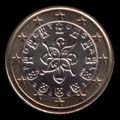Catalog of coins in Portuguese language countries
| Brazil | Portugal | ||
 |
Real |
 |
Euro |
| Cruzeiro real | |||
| Cruzeiro | Third Republic | ||
| Cruzado novo | |||
| Cruzado | Estado Novo | ||
| Cruzeiro novo | |||
| Cruzeiro antigo | First Republic | ||
| Real | |||
History of Portuguese and Brazilian real
Portuguese Real
The silver real, that worth 10 soldo (10 shillings, equal to 120 dinheiro or half a pound) was introduced by King Ferdinand I in 1380. The name comes from the Spanish silver coin real, introduced by King Peter I of Castile and Leon (1350-1369 ) under the name "nummus realis", which meant "the currency of the King." On the other hand, real was also the name of a former silver coin circulating in Spain and the Spanish colonies in America, that it was the eighth part of a peso.
King John I (1385-1433) introduced a new real, called "real branco" ("white real"), with a value of 70 soldo (equivalent to 840 dinheiro), adopted in 1433 as a unit of account by King Edward I, successor of John I. He coined also the "real preto" ("black real") in copper, worth a tenth of the real branco (equivalent to 7 soldo). During the reign of Manuel I (1495-1521), the name was simplified to real, with the beginning of coinage in copper. The archaic form of the plural of the currency was reis, while the modern form is reais.
In 1580 the last 1 real coin was minted. Then, the lower value coin was the 1½ réis, which was minted until about 1750. Later on, the smallest coin in circulation was that 3 réis, issued until 1875. The coins of 3, 5, 10, 20 and 40 réis were in copper, the coins of 50, 60, 100, 120, 240 and 480 réis were silver, while those of 480, 800, 1200, 1600, 3200 and 6400 réis were in gold. The standard gold coin was the 6400 reis, called peça, which became 7500 reis after 1826.
In 1837 the monetary system was decimalized, with new coins, initially in copper and then in bronze, for the 3, 5, 10 and 20 réis, in silver for the 50, 100, 200, 500 and 1000 réis, and in gold for 1000, 2000, 2500, 5000 and 10,000 reis. In 1900 50 and 100 réis coins began to be minted in cupro-nickel. In 1854, Portugal adopted the gold standard, with a ratio of 1000 réis = 1.62585 grams of fine gold. This standard was maintained until 1891.
Brazilian Real
The coins began to circulate in Brazil after the landing of the Portuguese navigator Pedro Alvares Cabral in the region on April 22, 1500. In addition to the Portuguese real used by the first settlers, in 1654 there were also reals coined by the Dutch in the north east of Brazil.
In 1690 the real became the official currency of Brazil. Following the invasion of Portugal by Napoleon Bonaparte in 1807, in 1808 John VI, King of Portugal, fled to Brazil, where he remained until 1821, when he came back to Portugal leaving in the country his son Peter IV. Following the troubles found in Portugal, Peter declared Brazil's independence on September 7, 1822, taking the name of Peter I and proclaiming the birth of the empire, with the annexation of the Cisplatina Province (now Uruguay) by John VI during the 1816-1820 war against José Gervasio Artigas,.
In 1889 Deodoro da Fonseca led a revolution with the proclamation of the Republic, forcing Peter II, son of Peter I, to abdicate and to return to Europe.
Due to inflation, at the end of the Old Republic (1889 - 1930) the base currency became initially the mil reis (one thousand reis) and subsequently the conto de reis (one million réis): notwithstanding the adoption of the gold standard in 1846, the mil reis had an equivalency with 822,076 mg of gold, then devalued to 180 mg of gold in 1926. In 1933 Brazil pegged the mil reis to the US dollar, at a rate of $ 1 = 12,5 mil reis.
End of the Portuguese real
After the Portuguese revolution on October 5, 1910 with the end of the monarchy on May 22, 1911, the real was replaced by the Portuguese escudo, at a ratio of 1,000 reis = 1 escudo.
End of the Brazilian real
In 1930 Getúlio Vargas was elected President of the Brazilian Republic, who began to concentrate power in his hands, until the dissolution of the National Congress and of the parties with the establishment in 1937 of a dictatorial government (Estado Novo), which lasted until 1945.
In 1942 the cruzeiro was introduced in Brazil, divided into 100 centavos, who replaced the real at a rate of 1 mil reis = 1 cruzeiro
